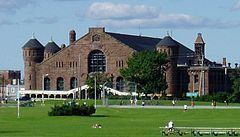Type Drill Hall / armoury Opened 1899 Construction started 1895 | Completed 1899 Floors 1 Owner Government of Canada | |
 | ||
Architectural style Romanesque Revival Style Current tenants 1st (Halifax-Dartmouth) Field Artillery Regiment, The Princess Louise Fusiliers, 33 (Halifax) Field Ambulance Similar CFB Halifax, Georges Island, York Redoubt, Halifax Common, Little Dutch (Deutsch) Church | ||
The Halifax Armoury is a prominent and historic structure in central Halifax Nova Scotia. The armoury is the home base of 1st (Halifax-Dartmouth) Field Artillery Regiment, The Princess Louise Fusiliers, and several other reserve units. The building remains an active military structure.
Contents
- Map of Halifax Armoury Halifax NS B3K 4B4 Canada
- Confidante toilet at halifax armoury
- Architecture
- History
- Restoration
- References
Map of Halifax Armoury, Halifax, NS B3K 4B4, Canada
Confidante toilet at halifax armoury
Architecture
The armoury was designed in 1895 by Chief Dominion Architect Thomas Fuller, and was opened the next year and work on the structure was completed in 1899. While the sandstone exterior is based on a medieval castle, it was actually one of the most advanced structures of its day. It was pioneering in its use of a series of Fink trusses to create a large interior space with no columns or walls, and is today the oldest surviving example of such a building. It was also one of the first buildings in Halifax to be lit by electricity.
History
It has played an important part in many Canadian wars, being an important transit point for soldiers before departing by ship for the Boer War and both World Wars. It was damaged in the Halifax Explosion in 1917, the west wall being displaced inward by about 60 centimeters. Still usable after the explosion, the armoury provided shelter for many who had lost their homes.
The building was designated a National Historic Site of Canada in 1989. In 1991, it was designated a Classified Federal Heritage Building.
Restoration
Major renovations were announced in January 2017 to restore the west wall to its original position after being damaged in 1917. Up to 20 percent of the wall required replacement and it was decided to use stone from the original quarry after the source was located in Beckwith, near Pugwash, Nova Scotia.
